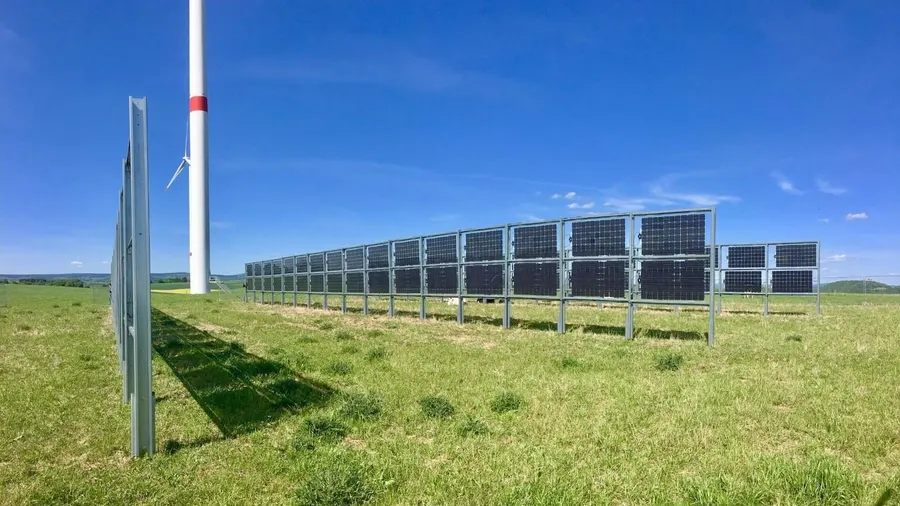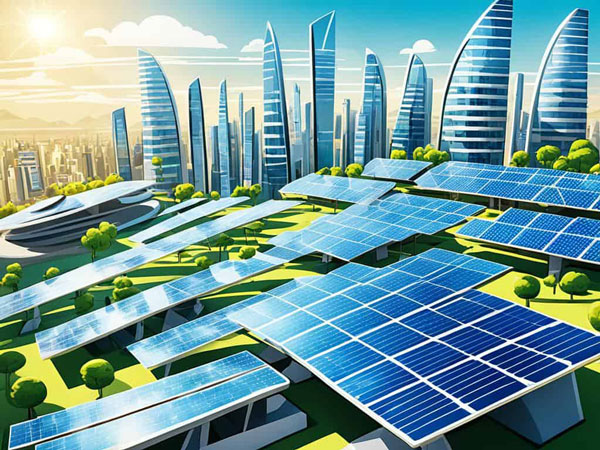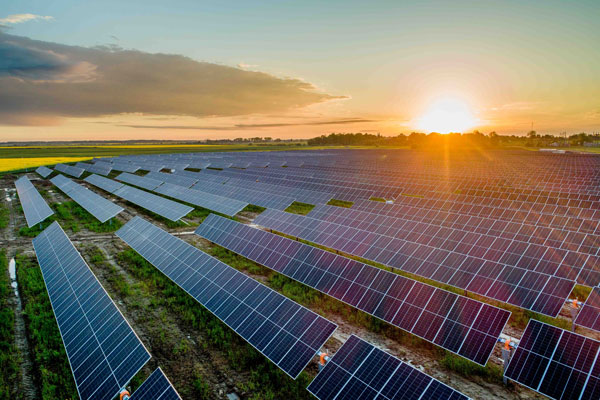How Bifacial Panels Work
Bifacial solar panels are designed to generate electricity from both sides by responding sunlight both on the front and rear panels, which enhance its benefits compared to monofacial solar panels. The panels house solar cells on both their front and back surfaces. Because they collect sunlight that strikes not only the front but are also able to reflect sunlight absorbed from the back of the panel, bifacial panels can actually produce additional power from the same sunlight exposure.
Central to that design is the capability to capture albedo radiation (light reflected off the ground or other surfaces back onto the panel). In contrast to mono-or-bi-facial single-junction cells, a bifacial solar panel mounted above a white gravel or concrete surface or a polar ice cap will be able to capture an additional 30% of sunlight, due to the light reflected from the white ground to the rear side of the panel.
Practical Applications
This means that in the real world 2 faced panels are the best, but only on large solar farms and commercial rooftops with big spaces that need to be divided for between higher angles and surface reflectivity. This is the recently commissioned solar farm in Colorado, USA with proprietary bifacial panels on single row tracker. The panels were tilted to allow the sun to make full use of them throughout the day. For other farms using traditional panels, the SunPower system increased energy yield up to 14 percent per year.
Installation Considerations
Bifacial solar panels pose certain installation challenges in order to operate at optimal efficiency. Panel mounting height: The height of the panels mounted will determine how much reflected light they can capture. Most of the times, the highest mount will bring more light in reflection and helps in more performance. Placing panels just one meter off the ground could increase the proportion of reflected solar radiation coming from the ground.
Economic Impact
In addition to magnetic forces and creating electricity, the sun is also known for helping energy companies, as these new solar panels can deliver up to 20%more energy per day per panel than traditional panels From an economic standpoint, while bifacial modules are more expensive for the average DIYer to purchase, they end up paying for themselves in the form of higher energy savings over an extended period of time Higher energy generation directly converts into improved electricity savings and reduced payback periods. One such report is a commercial building in California that started uses bifacial panels in which it reduce its energy bills by around 20% every year, with the system paying for itself within 4 years.
Environmental Benefits
Bifacial solar tech has other compelling environmental benefits as well. The Highland technology enables higher power levels to be delivered from the same physical footprint and reduces the redundancy and environmental impact associated with ground-mounted utility scale solar installations. Greater efficiency reduces the number of panels needed to generate a given amount of power, the carbon footprint of solar panel manufacturing is reduced too.

Key Benefits Over Traditional Panels
The key features that make them advantageous over conventional single-sided modules are mainly due to their design and efficiency of a bifacial solar panel.
Enhanced Energy Yield
The front and rear surfaces of bifacial panels can capture sunlight. For those that can, energy yield can be up to 10-25% higher depending on the installation environment. At a solar farm in Nevada, actual bifacial panels were found to make 15% more energy than single-sided ones under the same conditions, in part because the light was just right and the ground was suitable for reflection.
Lower Per Unit Cost (Per kw/hr)
The greater efficiency of bifacial modules translates directly into a lower levelized cost of electricity (LCOE) generated. This is essential for mass installation where aim is to have maximum output with minimum cost. One commercial solar installation in Arizona recorded an 18% reduction in the levelized cost of electricity (LCOE) when swapping from standard models to bifacial panels.
Longer Lasting
They often incorporate heavier duty manufacturing materials since both sides will be exposed to sunlight. This very solid build also provides a longer lifecycle and higher reliability - both key attributes for consistent energy production over time. Minnesota field test data showed that bifacial panels had an average annual degradation rate 5% lower than traditional ones.
Versatility in Installation
Bifacial panels are not only for large solar fields, but can also be hung vertically on building facades.Unlike traditional panels. Some of this adaptability comes from being partial shade plants, which means they can take indirect light. An Oregon project yielded new applications for bifacial panels, showing the potential of the technology to be integrated with vertical parking lot canopies to provide shade and shelter while producing power.
Positive Environmental Impact
Because they harness solar energy on both the front and back sides of a solar panel, bifacial panels require less land area for solar installations by making more productive use of the space the panels occupy, leaving more land in its natural habitat. Their higher capacity factor means they help to drive a large reduction in carbon emissions per unit of electricity generated. In Germany, researchers have calculated that using bifacials could slash the emissions generated by solar farms by a further 7% over their operational life, compared to conventional single-faced solar farms.
Market Growth and Industry Impact
The game changer is bifacial solar panels which are changing the dynamics in the solar industry, allowing massive market growth and massive disruption in the world of renewable energy.
Surge in Market Adoption
The bifacial solar panels are one of the fastest-growing solar panel technologies in the past few years. According to a recent analysis, the international bifacial solar panel market is expected to increase at a rate of 15% per annum in the following five years. Installations of bifacial panels have increased nearly 100 percent year-over-year in the United States and China, two markets that see the most use of the technology for its cost-effectiveness and efficiency attributes.
Such wide adoption has shaped solar projects developers and investors to a pivot from the usual solar to bifacial solar technologies.
Affect on Rooftop Solar Project Economics
In a sentence: These benefits of bifacial panels - higher energy yields and longer lifetime - have helped to change the economics of solar projects and make projects that were previously thought marginal, now finally viable. Large installations in Texas, saw roughly 12% overall project cost reductions by incorporating bifacials. In this case, they used the extra electricity produced to reduce the average price of electricity they offer through their PPAs.
Innovation and Technology Gains
As demand for bifacial technology increases, innovations are also being introduced in areas surrounding the product such as solar tracking systems and installation tactics. Specialized tracking systems that optimize panel angle - which can change throughout the day - are being developed by companies to increase capture, as are the newest dual-sided technology using bifacial panels. These included work on a dual-tilt tracker, which increased the annual energy yield of a California solar farm by more than 20%.
Broader Industry Impact
The move to new generation of bifacial solar panels is also encouraging a re-evalution of regulatory policies, and energy strategie. The potential of bifacial technology to play a role in achieving national energy goals is now dawning on governments and regulatory bodies. This recognition is culminating with more favorable policies ranging from tax credits for bifacial solar to changes in solar energy equipment standards.
Applications Expanding Their Use
Because of its light absorption capability from both sides, the increasing efficiency of the bifacial solar panels called it into action for several types of applications, forcing it to stretch so far beyond the limits of its typical solar energy application.
Large-Scale Solar Farms
The ability of bifacial solar panels to produce more energy has led to more and more large-scale solar farms adopting the solution. In Chile, a 1,000-acre solar farm has been topped by over 500,000 bifacial panels, this is just one example. Once operational, the installation is expected to produce 30 percent more energy each year than a similar-sized farm using conventional panels thanks to the novel design and the way in which light is reflected from the desert terrain adjacent.
Urban & Ruralenvironments
With space being a limiting factor in many urban environments, bifacial panels have emerged as an optimal solution for many solar projects. Usually these panels are applied in residential areas mainly as carports, balconies and rooftops, here their capability to capture light from more than one direction is the maximum. Bifacial panel on a New York city residential complexAn interesting application on a residential complex in New York city doubled energy yield by 25% when replacing traditional panels for bifacial ones.
Industrial Applications
Bifacial panels are also widely used in industrial applications to produce green power. A factory in Germany installed bifacial panels across its production facility's rooftop and walls, insects at the site also reduced their reliance on grid energy by 40%. This configuration not only provided the plant with the necessary power, but also greatly reduced its operating costs.
Innovative Configurations
The flexible nature of bifacial panels also facilitates unusual orientations, like vertical installations and incorporation into sound barriers bordering highways. In the Netherlands, a unique project implemented bifacial solar panels in highway noise barriers. More than simply managing traffic noise, these barriers were generating electricity to add back to the local grid, functioning in a manner that the traditional panels could not.
Agricultural Co-Utilization
In agrivoltaics, a new technology that allows for solar panels to be used on farmland that also provides shade for crops, bifacial panels are also employed. This use case is particularly beneficial in places with hot climates since traditional panels would otherwise increase the local heat load. This Arizona farm farms grass under bifacial panels, shading the plants while producing enough juice to power its irrigation and other electrical needs, a Climate Tech VC Acre tableau of carefully managed real-estate development housing both tail and dog.

Environmental Advantages
Bifacial solar panels are known for their extensive environmental contributions, which justify their increasing popularity in the field of renewable energy.
Enhanced Land Use Efficiency
Bifacial solar panels have a unique ability to increase the productivity of existing solar farms, allowing operators the flexibility to generate more energy within the same footprint. This results in more power generation from the same amount of area which eliminates the need for large land areas as required in traditional solar panels. A solar park in Nevada uses bifacial modules to achieve approximately 20% less energy land used for the same size of a conventional park essentially reducing the environmental print of solar generation.
Lower Carbon Emissions
By maximizing the amount of power produced for a given area, bifacial panels reduce carbon emissions associated with fossil-fuel-based energy production. A separate deep dive concluded that a 5 to 10 grams per kilowatt-hour reduction in carbon emissions from a bifacial facility over and above what standard panels accomplish could be a key to stalling or reversing global climate change.
Reduction in Water Usage
Cooling and cleaning operations, usually requiring substantial amounts of water, are also necessary in the manufacturing of solar panels. The added efficiency in a panel reduces the total amount of panels required to fulfil energy needs, and in turn reduces the water used in a panels' life cycle. A study of a solar plant in Arizona found that approximately 30% less water was needed to produce electricity when using bifacial panels.
Less Waste More Life
The stronger materials used in the construction of bifacial panels stand up better to environmental wear and tear, increasing operational lifespan and minimizing the frequency of replacements. This resilience results in the generation of less waste over the life of the photo voltaic energy facility. In Sweden, a solar facility found the life of bifacial panels in their setup was extended by five years due to the innovative technology, showing a reduction on resources required to manufacture and dispose of them.
Promoting Biodiversity
Bifacial panels hence have a dual-sided aspect, and the ability to function even in not-so-optimal conditions of partial shade can introduce interesting prospects to mesh solar power generation into the natural landscape, and even agricultural landscapes. The projects coupling bifacial panels with agrivoltaic systems have demonstrated increased power generation along with plant growth enhancement as well due to shading and reduced soil water evaporation. This idea has already proven to work in California, with a range of successful applications in agricultural-based farm fields to match renewable energy generation.





